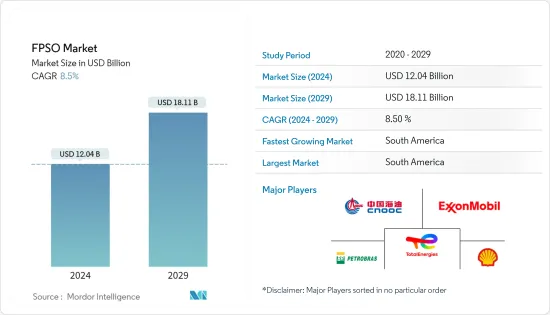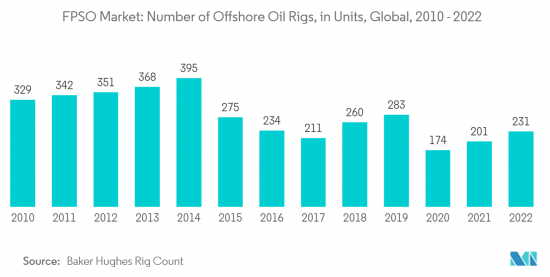 |
市場調査レポート
商品コード
1403937
FPSO:市場シェア分析、産業動向と統計、2024年~2029年の成長予測FPSO - Market Share Analysis, Industry Trends & Statistics, Growth Forecasts 2024 - 2029 |
||||||
● お客様のご希望に応じて、既存データの加工や未掲載情報(例:国別セグメント)の追加などの対応が可能です。 詳細はお問い合わせください。
| FPSO:市場シェア分析、産業動向と統計、2024年~2029年の成長予測 |
|
出版日: 2024年01月04日
発行: Mordor Intelligence
ページ情報: 英文 125 Pages
納期: 2~3営業日
|
- 全表示
- 概要
- 目次
FPSO市場規模は2024年に120億4,000万米ドルと推計され、2029年には181億1,000万米ドルに達すると予測され、予測期間中(2024年~2029年)のCAGRは8.5%で成長すると予測されます。

FPSO市場規模は今年末までに111億米ドルと推定・予測され、今後5年間で166億9,000万米ドルに達すると予測され、予測期間中のCAGRは8.5%を超えます。
主なハイライト
- 中期的には、深海や超深海での探査・生産活動の増加が予測期間中のFPSO市場を牽引するとみられます。
- 一方、初期費用が高いことが予測期間中の市場成長の妨げになると予想されます。
- とはいえ、FPSOシステムの技術的進歩と革新は、FPSO市場に大きなチャンスをもたらすと期待されています。
- 南米は、同地域でのオフショア活動の増加により、FPSO市場の支配的な地域になると予想されます。
FPSO市場動向
コントラクター所有のFPSOが市場を独占する見込み
- FPSOの調達方法には、主に新造、既存船の改造、既存ユニットの再配置の3つがあります。これらの選択肢のうち、再展開は、特定の分野向けにFPSOが高度にカスタマイズされるため、いくつかの課題があります。その結果、オペレーターは主に新造と改造のアプローチを好んでおり、過去20年間、これらのサービスを専門知識を持つ第三者請負業者に頼ることが多かった。
- コントラクター所有のFPSOは、オペレーター所有のFPSOや固定プラットフォームよりもコスト面で有利です。FPSOの設計、建設、操業に特化した請負業者は、規模の経済を実現し、船隊の稼働率を最適化できるため、オペレーターのコストを削減できます。このため、請負業者が所有するFPSOは、費用対効果の高いソリューションを求めるオペレーターにとって魅力的な選択肢となっています。
- コントラクター所有のFPSOは通常リース可能で、オペレーターに油田開発の柔軟性を提供します。リースにより、オペレーターは最小限の先行資本投資でFPSOにアクセスし、配備することができ、小規模オペレーターや生産プロファイルが不確かなプロジェクトに有利となります。
- オフショア活動の増加に伴い、探鉱・生産活動にかかるコストや、FPSO関連業務の請負業者へのアウトソーシングが増加しています。これにより、オペレーターは、FPSOのオペレーションを専門業者に任せて、最も価値を生み出せる分野に資源と注意を振り向けることができます。
- 例えば、Baker Hughes Rig Countによると、2022年末のオフショア・リグ数は約231基で、前年比約14.9%増となり、オフショアでの探査・生産活動が増加し、FPSOの需要が高まっています。
- 日本のFPSOサプライヤーであるMODECは2023年5月、ブラジル沖カンポス海盆のBM-C-33ブロック向けFPSO1隻をEquinorから受注しました。2027年完成予定のFPSOの納入に加え、MODECはEquinorに対し、FPSOの原油生産開始初年度の操業・保守サービスを提供します。その後、EquinorはFPSOの操業責任を引き継ぐ予定です。
- 従って、上記の点から、予測期間中はコントラクター所有のFPSOが市場を独占すると予想されます。

南米が市場を独占する見込み
- 南米地域は、世界のFPSO市場に最も大きな影響を与えると予想されます。特に、ブラジルとガイアナがこの市場の主要企業として台頭し、近年FPSOの需要が大幅に急増しています。
- 南米は、特にブラジルとガイアナに大きな石油・ガス埋蔵量があります。これらの埋蔵量は深海や超深海に位置しており、効率的な生産・貯蔵・積出のためにFPSOが必要とされています。これらの地域で大規模な発見と生産が行われる可能性があるため、FPSOの需要が高まっています。
- 例えば、ダイヤモンド・オフショアは2022年11月、ブラジルのペトロブラスから超深海セミ・サブマーシブル・リグ「オーシャン・カレッジ」の掘削プログラム契約を獲得しました。この契約は4年間で、さらに4年間延長できるオプションがついています。契約期間は4年で、契約総額は約4億2,900万米ドルと推定され、これには出動料とサービス提供料が含まれます。
- さらに、南米には、特にブラジルのサントス盆地とカンポス盆地に豊富なプレソルト埋蔵量があります。これらの埋蔵量は厚い塩の層の下にあり、探査と生産に技術的な課題をもたらしています。FPSOは、深海で安全に操業でき、プレソルト油田の複雑な処理要件を処理できるため、こうした厳しい環境に適しています。
- したがって、上記の点から、予測期間中、南米地域がFPSO市場を独占すると予想されます。
FPSO産業の概要
FPSO市場は半固定的です。市場の主要企業(順不同)には、Petroleo Brasileiro SA(ペトロブラス)、CNOOC Ltd、TotalEnergies SE、Exxon Mobil Corp.、Shell PLCなどがあります。
その他の特典:
- エクセル形式の市場予測(ME)シート
- 3ヶ月間のアナリスト・サポート
目次
第1章 イントロダクション
- 調査範囲
- 市場の定義
- 調査の前提
第2章 調査手法
第3章 エグゼクティブサマリー
第4章 市場概要
- イントロダクション
- 2028年までの市場規模および需要予測(単位:米ドル)
- FPSO稼動状況(地域別・オペレーター別)(2022年)
- 最近の動向と展開
- 政府の規制と政策
- 市場力学
- 促進要因
- 海洋石油・ガス探査・生産活動の増加
- エネルギー需要の増大
- 抑制要因
- 高い初期費用
- 促進要因
- サプライチェーン分析
- ポーターのファイブフォース分析
- 供給企業の交渉力
- 消費者の交渉力
- 新規参入業者の脅威
- 代替品の脅威
- 競争企業間の敵対関係の強さ
第5章 市場セグメンテーション
- 所有権
- 事業者所有
- 業者所有
- 水深
- 浅瀬
- 深海
- 超深海
- 地域別市場分析{2028年までの市場規模・需要予測(地域別のみ)}:日本
- 北米
- 米国
- カナダ
- その他の北米
- 欧州
- ノルウェー
- 英国
- ロシア
- オランダ
- その他の欧州
- アジア太平洋
- 中国
- インド
- オーストラリア
- インドネシア
- その他のアジア太平洋
- 南米
- ブラジル
- アルゼンチン
- ベネズエラ
- その他の南米
- 中東・アフリカ
- サウジアラビア
- アラブ首長国連邦
- ナイジェリア
- アルジェリア
- その他の中東・アフリカ
- 北米
第6章 競合情勢
- M&A、合弁事業、提携、協定
- 主要企業の戦略
- 企業プロファイル
- FPSO Contractors
- Modec Inc.
- SBM Offshore NV
- BW Offshore Limited
- Teekay Offshore Partners LP
- Bluewater Holding BV
- Saipem SpA
- Petrofac Limited
- FPSO Operators
- Petroleo Brasileiro SA(Petrobras)
- CNOOC Ltd
- TotalEnergies SE
- ExxonMobil Corp.
- Chevron Corporation
- Shell PLC
- BP PLC
- FPSO Contractors
第7章 市場機会と今後の動向
- 技術の進歩と革新

The FPSO Market size is estimated at USD 12.04 billion in 2024, and is expected to reach USD 18.11 billion by 2029, growing at a CAGR of 8.5% during the forecast period (2024-2029).
The FPSO market is estimated to be at USD 11.10 billion by the end of this year and is projected to reach USD 16.69 billion in the next five years, registering a CAGR of over 8.5% during the forecast period.
Key Highlights
- Over the medium term, the increasing exploration and production activities in deep and ultradeep water depths are expected to drive the FPSO market during the forecasted period.
- On the other hand, the high upfront cost is expected to hinder the market's growth during the forecasted period.
- Nevertheless, the technological advancements and innovation in FPSO systems are expected to create huge opportunities for the FPSO market.
- South America is expected to be a dominant region for the FPSO market due to the increasing offshore activities in the region.
FPSO Market Trends
Contractor-owned FPSO Expected to Dominate the Market
- There are three primary methods for procuring FPSOs: new build, conversion of an existing vessel, and redeployment of an existing unit. Among these options, redeployment poses several challenges due to the highly customized nature of the FPSO for a specific field. As a result, operators have predominantly favored the new build and conversion approaches, often relying on third-party contractors with specialized expertise for these services over the past two decades.
- Contractor-owned FPSOs offer cost advantages over operator-owned FPSOs or fixed platforms. Contractors, who specialize in designing, constructing, and operating FPSOs, can achieve economies of scale and optimize their fleet utilization, resulting in reduced operator costs. This makes contractor-owned FPSOs an attractive option for operators seeking cost-effective solutions.
- Contractor-owned FPSOs are typically available for lease, providing operators greater flexibility in field development. Leasing allows operators to access and deploy FPSOs with minimal upfront capital investments, benefiting smaller operators or projects with uncertain production profiles.
- With the increasing offshore activities, the cost of exploration and production activities and outsourcing the FPSO-related activities to contractors. This allows operators to allocate their resources and attention to areas where they can create the most value, leaving the FPSO operations to specialized contractors.
- For instance, according to Baker Hughes Rig Count, at the end of 2022, there were around 231 offshore rigs, the offshore rigs witnessed about 14.9% campared to previous year, signifying an increase in offshore exploration and production activities, consequently driving the demand for FPSOs.
- In May 2023, MODEC, a Japanese FPSO supplier, secured a contract from Equinor to supply an FPSO vessel for the BM-C-33 block in the Campos Basin offshore Brazil. In addition to delivering the FPSO, expected to be completed by 2027, MODEC will provide Equinor with operations and maintenance services for the first year of the FPSO's oil production. Subsequently, Equinor plans to take over the operational responsibilities of the FPSO.
- Therefore as per the points mentioned above, the Contractor-owned FPSO is expected to dominate the market during the forecasted period.

South America Expected to Dominate Market
- The South American region is anticipated to exert the highest influence on the global FPSO market. Particularly, Brazil and Guyana have emerged as key players in this market, experiencing a significant surge in demand for FPSOs in recent years.
- South America has significant offshore oil and gas reserves, particularly in Brazil and Guyana. These reserves are located in deepwater and ultra-deepwater areas, requiring FPSOs for efficient production, storage, and offloading. The potential for large-scale discoveries and production in these regions drives the demand for FPSOs.
- For instance, in November 2022, Diamond Offshore secured a drilling program contract from Petrobras in Brazil for its ultra-deepwater semi-submersible rig, Ocean Courage. The contract spans four years, with an unpriced option to extend for another four years. The firm term of the contract is estimated to be valued at around USD 429 million, which includes a mobilization fee and provision of services.
- Moreover, South America has extensive pre-salt reserves, especially in Brazil's Santos and Campos Basins. These reserves are located beneath thick layers of salt, presenting technical challenges for exploration and production. FPSOs are well-suited for these challenging environments, as they can safely operate in deepwater and handle the complex processing requirements of pre-salt fields.
- Therefore, as per the above points, the South American region is expected to dominate the FPSO market during the forecasted period.
FPSO Industry Overview
The FPSO market is semi consolidated. Some of the major players in the market (in no particular order) include Petroleo Brasileiro SA (Petrobras), CNOOC Ltd, TotalEnergies SE, Exxon Mobil Corp., and Shell PLC.
Additional Benefits:
- The market estimate (ME) sheet in Excel format
- 3 months of analyst support
TABLE OF CONTENTS
1 INTRODUCTION
- 1.1 Scope of the Study
- 1.2 Market Definition
- 1.3 Study Assumptions
2 RESEARCH METHODOLOGY
3 EXECUTIVE SUMMARY
4 MARKET OVERVIEW
- 4.1 Introduction
- 4.2 Market Size and Demand Forecast in USD, till 2028
- 4.3 FPSOs in Operation, by Region and Operator, 2022
- 4.4 Recent Trends and Developments
- 4.5 Government Policies and Regulations
- 4.6 Market Dynamics
- 4.6.1 Drivers
- 4.6.1.1 Increasing Offshore Oil and Gas Exploration and Production Activities
- 4.6.1.2 Growing Demand for Energy
- 4.6.2 Restraints
- 4.6.2.1 High Upfront Costs
- 4.6.1 Drivers
- 4.7 Supply Chain Analysis
- 4.8 Porter's Five Forces Analysis
- 4.8.1 Bargaining Power of Suppliers
- 4.8.2 Bargaining Power of Consumers
- 4.8.3 Threat of New Entrants
- 4.8.4 Threat of Substitute Products and Services
- 4.8.5 Intensity of Competitive Rivalry
5 MARKET SEGMENTATION
- 5.1 Ownership
- 5.1.1 Operator-owned
- 5.1.2 Contractor-owned
- 5.2 Water Depth
- 5.2.1 Shallow Water
- 5.2.2 Deep Water
- 5.2.3 Ultra-deep Water
- 5.3 Geography Regional Market Analysis {Market Size and Demand Forecast till 2028 (for regions only)}
- 5.3.1 North America
- 5.3.1.1 United States
- 5.3.1.2 Canada
- 5.3.1.3 Rest of North America
- 5.3.2 Europe
- 5.3.2.1 Norway
- 5.3.2.2 United Kingdom
- 5.3.2.3 Russia
- 5.3.2.4 Netherland
- 5.3.2.5 Rest of Europe
- 5.3.3 Asia-Pacific
- 5.3.3.1 China
- 5.3.3.2 India
- 5.3.3.3 Australia
- 5.3.3.4 Indonesia
- 5.3.3.5 Rest of Asia-Pacific
- 5.3.4 South America
- 5.3.4.1 Brazil
- 5.3.4.2 Argentina
- 5.3.4.3 Venezuela
- 5.3.4.4 Rest of South America
- 5.3.5 Middle-East and Africa
- 5.3.5.1 Saudi Arabia
- 5.3.5.2 United Arab Emirates
- 5.3.5.3 Nigeria
- 5.3.5.4 Algeria
- 5.3.5.5 Rest of Middle-East and Africa
- 5.3.1 North America
6 COMPETITIVE LANDSCAPE
- 6.1 Mergers and Acquisitions, Joint Ventures, Collaborations, and Agreements
- 6.2 Strategies Adopted by Leading Players
- 6.3 Company Profiles
- 6.3.1 FPSO Contractors
- 6.3.1.1 Modec Inc.
- 6.3.1.2 SBM Offshore NV
- 6.3.1.3 BW Offshore Limited
- 6.3.1.4 Teekay Offshore Partners LP
- 6.3.1.5 Bluewater Holding BV
- 6.3.1.6 Saipem SpA
- 6.3.1.7 Petrofac Limited
- 6.3.2 FPSO Operators
- 6.3.2.1 Petroleo Brasileiro SA (Petrobras)
- 6.3.2.2 CNOOC Ltd
- 6.3.2.3 TotalEnergies SE
- 6.3.2.4 ExxonMobil Corp.
- 6.3.2.5 Chevron Corporation
- 6.3.2.6 Shell PLC
- 6.3.2.7 BP PLC
- 6.3.1 FPSO Contractors
7 MARKET OPPORTUNITIES AND FUTURE TRENDS
- 7.1 Technological Advancements and Innovation
